A kayaker’s chronicle: Part three of three: Sewage and stormwater flow through the same pipes in Holyoke, Chicopee and Springfield
| Published: 08-11-2023 1:27 PM |
Editor’s note: This is part three of a three-part series chronicling the current state of the Connecticut River as it runs through Massachusetts, in light of the recent U.S. Supreme Court decision to limit the Clean Water Act. In part three, writer Anna Laird Barto returns to the river for the first time after recent catastrophic flooding made it unsafe for swimmers and boaters.
A blue plastic deck chair bobs in the muddy water about 50 feet from shore. I wonder how far it’s traveled downstream over the past two weeks, since flood waters swept through the Valley, damaging roads and homes and laying waste to the fields of ripening corn and other crops I’ve come to know so well over the course of my river journey.
This is my first time back on the river since the flood. At first glance it doesn’t look that different. A few more sticks and small logs float alongside me, but nothing that would pose a danger to a 10-foot kayak. Larger debris — tree trunks, wooden planks, and chunks of blue foam from the underside of docks — have lodged against the bridge pilings.
Paddling closer to shore, I notice plastic bags, tangled fishing line, and leaf litter snagged on the tree limbs above my head. The vegetation along the banks is flattened and coated with dried silt for about three to five feet above the current waterline. Where there isn’t vegetation, I can see where the river carved away chunks of sediment.
I embarked on this trip to understand the role of our laws, like the 1972 Clean Water Act, in caring for our watershed. I never wanted or anticipated that natural events would reveal just how high the stakes are.
For decades, scientists have predicted that these kinds of weather events will become frequent and intense, but it doesn’t really hit home until floods take out your road to work and the farmer down the road is on CNN talking about federal disaster relief.
The good news is that here in the valley, communities are already coming together to respond to the challenges posed by climate change.
Since 1962, the Pioneer Valley Planning Commission (PVPC) has worked to increase communication, cooperation and coordination between local government, private business and civic sectors in Hampshire and Hampden Country. Among the PVPC’s top priorities are water quality and climate change mitigation.
Article continues after...
Yesterday's Most Read Articles
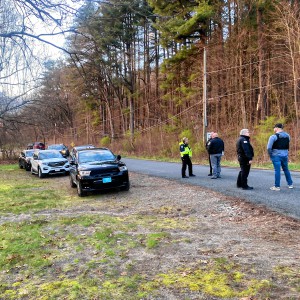 Police report details grisly crime scene in Greenfield
Police report details grisly crime scene in Greenfield
 Super defers Amherst middle school principal pick to successor; one finalist says decision is retaliation for lawsuit
Super defers Amherst middle school principal pick to successor; one finalist says decision is retaliation for lawsuit
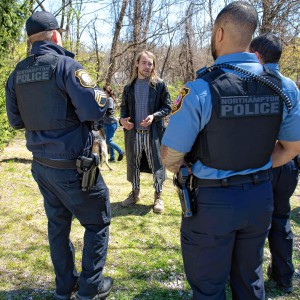 Homeless camp in Northampton ordered to disperse
Homeless camp in Northampton ordered to disperse
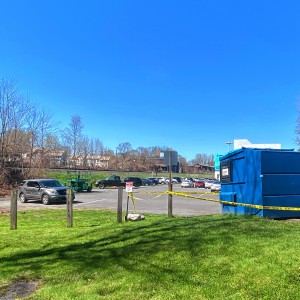 Authorities ID victim in Greenfield slaying
Authorities ID victim in Greenfield slaying
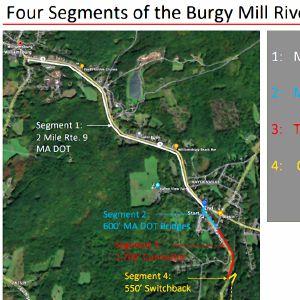 Haydenville residents resist Greenway trail plan, float alternative design
Haydenville residents resist Greenway trail plan, float alternative design
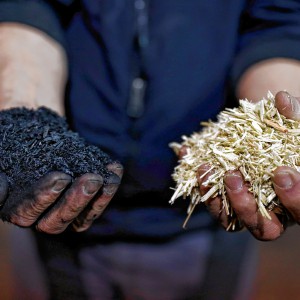 Locking up carbon for good: Easthampton inventor’s CO2 removal system turns biomass into biochar
Locking up carbon for good: Easthampton inventor’s CO2 removal system turns biomass into biochar
“One of the things that we definitely believe here at the PVPC is that all water is connected,” said PVPC Executive Director Kimberly Robinson. “I think bringing information first and foremost to this issue is key, and helping folks make good decisions to adapt to these new dynamics.”
The PVPC helps its community partners connect with the funding necessary to implement water quality improvement projects and meet the requirements for federal stormwater permits created under the Clean Water Act.
Robinson stresses the importance of delving into these issues with the communities and providing as much information as possible when planning on the ground.
“These problems have become so complicated,” she said. “It’s taking a much bigger pool of talent to think about these and come up with solutions.”
From the viewing platform at the South Hadley Public Library, I watch the water surge over the Holyoke Dam, also called the South Hadley Falls Dam. The municipally owned Holyoke Dam hasn’t come under the same fire from environmentalists as its upstream counterpart in Turners Falls.
“You know, a dam is a dam,” said Kelsey Wentling of the Connecticut River Conservancy. “But they have pretty good conditions in (Holyoke), like things that allow for fish passage and water flow.”
Below the dam, farm fields are replaced by 100-year-old brick industrial buildings, like the HG&E Power House I pass on my right as I approach the Willimansett Bridge. It seems like every few hundred feet there’s a culvert or pipe jutting from the river banks, but maybe I’ve just become hyper-aware of these sewer outflows.
The recent flooding was not only devastating because it washed out roads and rotted crops, but because it contaminated fields with raw sewage. This means that even crops which survived the floods intact do not meet food quality standards because of high levels of E.coli and other bacteria. In some cases, contaminated fields may not be replantable for years to come.
Following last month’s torrential rain, millions of gallons of untreated sewage were released into the Connecticut River and its major tributaries; six million from Holyoke alone. How is it that 50 years after the Clean Water Act, sewage can still be discharged into our waterways?
“We’re talking about systems that were built over 100 years ago,” Robinson told me. “At the time, folks did not understand water and water flow in the same way that we do now.”
Older cities, including Holyoke, still have what’s called Combined Sewer Overflows, or CSOs, in which sewage and stormwater flow through the same pipes to water treatment facilities. Intense rainfall can cause these combined systems to overflow into adjacent bodies of water.
When the PVPC first started working on CSO issues in the 90s, seven area communities used CSOs. Today, only three remain: Springfield, Chicopee and Holyoke. In the last nine years, the PVCP has brought in more than $12 million dollars to address combined sewer overflows.
Robinson said that state grants and revolving fund programs, which offer low- or no-interest loans to communities, have been hugely enabling, but there’s no magic wand. Dismantling these legacy systems is time-consuming and expensive, which places an undue burden on our poorest communities.
“I think it’s important to acknowledge the heavy lift that this is in those three remaining communities and that they are able to keep moving on,” Robinson said. “This is huge and there’s tremendous interest in resolving this issue, but it’s a long-term solve.”
“We are constantly so impressed with the individuals who do this work in those communities,” she added. “We’ve consistently found that the staff at these various departments are so committed to clean water and they are working every day to try and assist around finding the solutions around the legacy system pieces.”
Route 91 and the Amtrak rumble along the eastern bank, but on the Agawam side suburban lawns slope down to backyard docks. Sailboats tack back and forth across the wide channel, the roller coasters of Six Flag New England rising in the background.
“One of the things that is really close to my heart is just how many people are out in the river now that we never saw before,” said PVCP Chief Environmental Planner Patty Gambarini, who grew up in the Hartford area. She points to the number of rowing clubs and public boating houses along the Connecticut. “Our kids are out on the river, rowing. You and I didn’t grow up with that.” That the river is usually clean enough for boating and even swimming, is a credit to the Clean Water Act, state environmental laws, local investment, and the hard work of advocates like the PVCP and Connecticut River Conservancy.
As I near the Connecticut border, the river looks more like it did when I started out from Northfield two months ago. The shady banks on my left belong to the Silvio O. Conte Fish & Wildlife Refuge. Thanks to a partnership between the Nature Conservancy, the town of Longmeadow, and other local organizations, the adjacent fields have been restored, creating the largest floodplain forest of its kind in the Connecticut River watershed.
Wetlands like these are just as key to climate resilience as updated sewer systems and pollution controls.
“Wetlands are part of the water body,” said Scott Jackson of the University of Massachusetts Amherst Extension School. “Where you have wetlands that are separate from there then they can collect water and prevent rapid movement of water through the landscape which causes flooding.” Wetlands also are effective at removing contaminants that would otherwise result in toxic algae blooms, fish kills, and even unsafe drinking water.
The U.S. Supreme Court’s May ruling in Sackett v. EPA, placed in jeopardy an estimated half of America’s wetlands, which do not meet the new judicial standard of “continuous surface connection” to a traditional navigable waterway.
After my conversations with farmers, environmentalists and community planners, I’m feeling more optimistic about the future health of the Connecticut River here in Massachusetts, but as I’ve heard so many times over the course of my journey, all waters are connected. We can’t afford to be complacent because Massachusetts and the other three states that make up the Connecticut River watershed have strong environmental laws and a culture of environmental stewardship.
I’m heralded across the finish line by the distant strains of the Superman theme from Superman The Ride at Six Flags. If it weren’t for the blue dot on my phone I wouldn’t know I was in Connecticut. The river doesn’t care about a dotted line on Google Maps. After all, all waters are connected, and we’re connected to them. That’s why we can’t only care about the health of our river, but all rivers.
Originally from Amherst, Anna Laird Barto lived everywhere from Wisconsin to Mexico before returning to the Valley. She currently lives in Montague and works as a freelance writer and a family support worker at a local nonprofit. She holds an MFA from Emerson College in Boston and has published fiction and nonfiction in various publications including YES! Magazine, Explore, Fodor’s Travel, Hobart and Wanderlust Journal. Visit her at annalairdbarto.com or @annalairdbarto.

 Valley Bounty: Grass-fed animals that feed the grass: Gwydyr Farm in Southampton focuses on ‘restoring the connection between land, food and people’
Valley Bounty: Grass-fed animals that feed the grass: Gwydyr Farm in Southampton focuses on ‘restoring the connection between land, food and people’ Weekly Food Photo Contest: This week’s winner: Mary Chicoine of Easthampton
Weekly Food Photo Contest: This week’s winner: Mary Chicoine of Easthampton  Speaking of Nature: A romantic evening for two birders — To hear the wonderful sounds of the Saw-whet Owl one must go outside at night
Speaking of Nature: A romantic evening for two birders — To hear the wonderful sounds of the Saw-whet Owl one must go outside at night Speaking of Nature: Where have all the birds gone?: They’re there, and here’s a handy tool to keep track of their appearances
Speaking of Nature: Where have all the birds gone?: They’re there, and here’s a handy tool to keep track of their appearances
